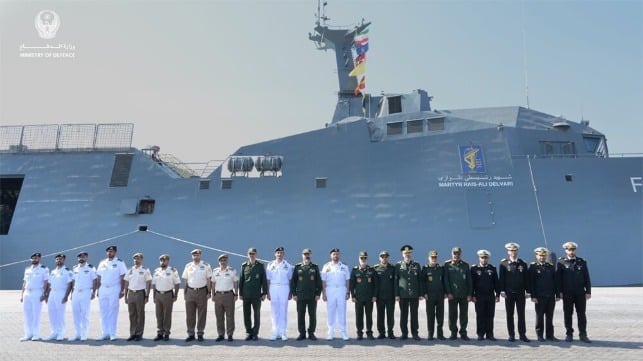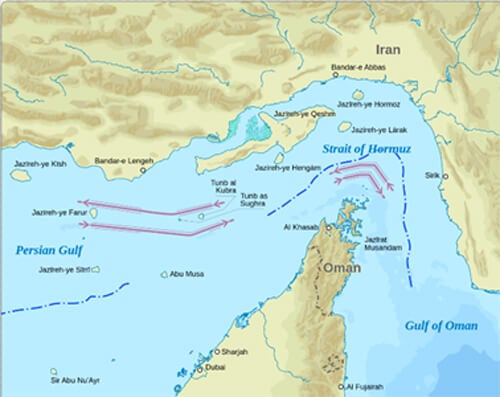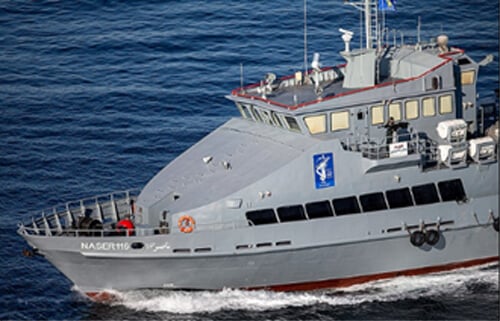Iranian Naval Forces Make an Unusual Port Call to the UAE

In an unusual defense diplomatic development, ships of the IRGC Navy (Nesda) and regular Iranian Navy (Nejada) have conducted a joint port visit to the United Arab Emirates.
The UAE Ministry of Defense website showed a picture of the Shahid Soleimani Class missile corvette Shahid Rais Ali Delvari (FS313-04) being greeted at the dockside in Sharjah on arrival. The Shahid Rais Ali Delvari, the fourth ship in its class, was only unveiled as having joined the Nesda fleet in mid-January, so this will probably have been its first overseas port visit and operational deployment.

The Iranian naval visitors alongside in Sharjah’s Mina Khalid, February 3 (Iranian MoD)
???? ????? ??? ????? ???? / ??????? ??? 4 ??? ????? ??????? ?? ????? ?????? ?????? ??? 3 ???? ???? ?? ??????? ????? ???????????????? ??? ?????? ?????? ????????? ??? ?? ????? ??????? ?????? ??????? ?????? ?????? ????? ???????? ??????? ???????. pic.twitter.com/MiiZLjp3BR
— ????? ?????? |MOD UAE (@modgovae) February 3, 2025
The other vessels taking part in the visit are the Nesda’s small missile corvette Abu Mahdi al-Muhandis (PC313-01) with the Nasser Class auxiliary Shahid Sattar Mahmoodi (Naser-116), and the Nedaja’s Sina Class fast attack craft IRINS Zereh (P235). It appears unlikely that the flotilla will undertake any joint training with the Emiratis.
The choice of Sharjah as a port to host the Iranian visit has some significance. It is not an Emirati naval base, so docking the Iranian vessels in a civilian port will have protected Emirati – and allied – operational security. But of greater significance, Sharjah was the Emirate that was administering the island of Abu Musa when it was seized by Imperial Iranian forces on November 30, 1971. The seizure came a day after the Emirate of Sharjah had agreed to share sovereignty of the island with Iran, which the seizure then contravened. Sharjah continued thereafter to maintain civil administration and a small police presence on its portion of the island in support of the small residual Emirati population, despite increased restrictions imposed by Iran. Whereas Little Tunb and Greater Tunb islands which Iran also seized (from the Emirate of Ras Al Khaimah) at the same time lie close off the Iranian coast, Abu Musa sits midway in the middle of the Gulf. If Emirati sovereignty over the island was ever recovered, it would expand the Emirati sphere of influence in the Gulf significantly northwards.

The timing of this first Iranian naval visit is of significance. The Iranian security establishment is currently suffering a high degree of nervousness, fearing a further potential attack by Israel, uncertain about President Trump’s intentions, and worried by an increase of internal security issues both in border areas and in Tehran; following the assassination of two senior judges in Tehran recently, the Supreme Leader Ali Khamenei has even been seen to be wearing a flak jacket in a public appearance. However, regional instability which might follow upheavals in Iran would be bad for trade. Hence a naval exchange of this sort, supportive of maintaining the status quo, might in the Emirati calculation be in the UAE’s best interests.
Before the Iranian ships departed, the senior Nesda officer on board, Commander of the 5th IRGC Naval Region Rear Admiral Ramezan Abdollahi who is normally based in Bandar Lengeh, paid a visit to the UAE Naval Commander Major General Humaid Mohammed Al Rumaithi in his office in Abu Dhabi.

Nesda Auxiliary Shahid Sattar Mahmoodi (Naser-116) (FARS/Iranian Mod)
